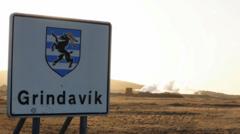A volcanic eruption has commenced on the Reykjanes Peninsula in south-west Iceland, with the event starting around 09:45 local time (10:45 BST) just north of the town of Grindavík. According to Iceland's Meteorological Office, less than an hour after the eruption began, a crack in the ground had expanded to 700 meters (2296 ft) and continues to grow. This eruption follows hundreds of seismic activities reported in the area known as Sundhnúks Crater Row as early as 06:30 local time.
Grindavík, along with the nearby Blue Lagoon spa—a popular tourist spot—was preemptively ordered to evacuate, showcasing the region’s consistent vulnerability to volcanic activity. Roads in and out of Grindavík remain closed, although flight operations have not been affected.
By 11:00 local time, the original fissure had continued to extend southward while a new crack had opened nearby. Authorities have reiterated the urgency for any remaining residents in Grindavík to evacuate, noting earlier reports of some individuals choosing to stay despite evacuation orders. The police chief, Úlfar Lúðvíksson, noted that only about 40 homes remain occupied following prior volcanic activities. The majority of Grindavík's 4,000 residents were permanently evacuated in November 2023, in preparation for subsequent eruptions that occurred in December 2023 and in earlier 2024.
The current magma tunnel extending under the crater series measures approximately 11 km (6.8 miles), marking the longest measurement since November 11, 2023. Based on wind patterns, officials have indicated that gas emissions from the eruption are expected to drift northeast toward the capital area, raising public health concerns.
Iceland has witnessed multiple eruptions along the Reykjanes Peninsula since 2021, marking a significant reawakening in volcanic activity in an area that had been dormant for 800 years, when eruptions persisted for decades. As a volcanic hotspot, Iceland remains on the Mid-Atlantic Ridge, which marks the boundary of two major tectonic plates.





















